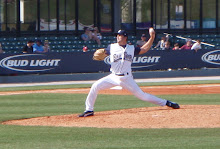As a left-handed pitcher, I grew up hearing how lucky I was to be left-handed. "All lefties are so lucky" they would say. "Lefties have more movement and some throw natural curves" were a few of sayings the little league dads would remark. So what is it about us southpaws that seem to make us so unique?
For starters, only 13% of the world's population is left handed. So naturally, there are less of us out there. Let's face it, we live in a right handed world. Hitters are used to facing right handed pitchers from little league on up through the big leagues. When they see a guy throwing with the "wrong" arm, it takes some getting used to. This difficulty is compounded when a left handed hitter attempts to hit off a lefty pitcher. Not only are they not used to seeing a lefty, the ball is also coming out from behind the hitter. This just compounds the trouble.
Also, many left handed little leaguers do have a tendency to throw with their hand on the side of the ball, causing it to move or run away from a right handed hitter. Of course, righties can do this too, but many of them seem to have more trouble developing this movement. I don't have a sound explanation for this phenomena, but I do have my theory. I can't prove it, but it makes sense to me, so I will share it with you.
The theory is as follows: We know the Earth rotates West to East or counter-clockwise if looking down from the North Pole. This rotation, in conjunction with the orbit of the Earth around the sun creates magnetic fields that pull on the different polar regions. For righties, the pronation of their throwing arm (turning inwards) on release must create a type of spin that is in unison with the Earth's gravitational and rotational forces. On the contrary, I believe the left-handed pitcher creates a spin that is in direct contradiction to these forces. As a baseball thrown by a lefty travels through the air, these unique forces pulling on the baseball create the added movement that a hitter see's when facing the Tom Glavine of their respective league. Now as I said, I don't have the scientific equations to prove my theory, but it does appear to be true based on the extra movement that most lefties have.
If anyone out there has a better explanation, I'd love to hear about it. In the mean time, that's my story and I'm sticking to it.
Until Next Time!!
P.S. I am totally kidding about my theory (but not really).
Subscribe to:
Post Comments (Atom)

I've caught many right-handed and left-handed pitchers. There is no difference in the amount of movement, it's just from the other side. The right-handed delivery and movement and the left-handed delivery and movement are mirror images. This whole "natural curve" phenomena is false. It's not as if left-handed pitchers have a different bones or muscles. Ball movement comes down to mechanics and grip -- not left vs right.
ReplyDeleteYou're exactly right about it coming down to mechanics and grip. But it is true that lefties tend to have a natural curve. As a lefty, I've been trying to figure out why this happens to be true. Just like you said, it's about the grip. If you're a righty, you might not know this, but when is lefties write, we have to curl our hand inward and drag it above the writing or else we'd just end up smearing the ink/led all over the place. (It sucks and most righties don't think about that. They even tried making a left handed spiral notebook with the spirals on the right side, but obviously that didn't do shit to fix our problem). Anyway, I believe that since we've been writing with our hands curled in and on top of the lines ever since we were wearing diapers, we naturally grip the ball slightly to the left side which puts curve on the ball. And even if we grip it evenly in the center, our hands curl down and in before releasing it, which has even more of a curving effect than gripping it to curve. I've been able to put curve on the ball regardless of how I grip it
DeleteSpeaking as a physicist, it is unlikely magnetic fields on a baseball, however, there are equations of motion for Coriolis forces (i.e. the ones that make the water in the toilet bowl swirl different in the northern and southern hemisphere), do exist, and you could calculate how much that is... FYI
Delete